
TEXAS BOASTS THE SECOND LARGEST ECONOMY IN THE UNITED STATES AND HAS HAD THE LONGEST SUSTAINED ECONOMIC EXPANSION IN AMERICAN HISTORY.[ 1 ]
But today, around 65% of jobs nationwide require at least some postsecondary education. And like all states, Texas has current average attainment levels below those required for the jobs of the future.[ 2 ] The increasing demand for a postsecondary credential means that Texas will have to do more to sustain economic growth long-term. To keep the momentum going and prepare young people for the future economy, Texas set a goal for 60% of young adults in the state to obtain a postsecondary credential by 2030.[ 3 ] But postsecondary completion growth has slowed in recent years among Black students, Latino students, and students from low-income backgrounds in Texas.[ 4 ] The state is only halfway toward meeting its postsecondary completion goal for students from low-income backgrounds, 55% toward its goal for Black students, and only 41% toward its goal for Latino students.[ 5 ] These inequities in education have direct economic consequences.[ 6 ]
In addition, COVID-19 has upended Texas’ economic future and threatens to further derail the state’s postsecondary goals. The pandemic has disrupted students’ academic trajectories and has already negatively impacted college plans, especially those of students from low-income backgrounds, Black students, and Latino students.[ 7 ] Texas undergraduate enrollment for fall 2020 is down 3.4% from last year, according to recent reporting.[ 8 ] As schools and districts work to deliver remote or in-person instruction, it is critical that students have opportunities to prepare for their future. Advanced and rigorous courses can offer students a clear path toward college and career by preparing students with challenging curriculum and allowing students to earn college credit. But nationally, Black and Latino students, and students from low-income backgrounds are assigned at much lower rates to advanced courses than their peers.[ 9 ] The same is true in Texas. To get Texas on track to meet its postsecondary goals, state efforts must be made to increase access to and success in rigorous and advanced courses for students who are persistently excluded.
POSTSECONDARY COMPLETION GROWTH HAS SLOWED IN RECENT YEARS AMONG BLACK STUDENTS, LATINO STUDENTS, AND STUDENTS FROM LOW-INCOME BACKGROUNDS IN TEXAS
60X30TX: A PLAN FOR TEXAS’ FUTURE
Recognizing education as key to sustaining economic growth, Texas launched a higher education strategic plan called 60x30TX in 2015. The overarching goal of 60x30TX is that 60% of young adults ages 25-34 in Texas will hold a postsecondary certificate or degree by 2030. The plan aims for at least 550,000 students to earn a postsecondary credential (certificate, associate, bachelor’s, or master’s) from a Texas institution of higher education in 2030, complete programs with identified marketable skills, and limit the student loan debt of graduates.[ 10 ] The plan also calls for Texas to increase the number of certificates and degrees earned by Latino and Black students to at least 285,000 and 76,000, respectively, by 2030.[ 11 ] This vision for Texas responds to an increased demand for more aligned skills and credentials in the labor market.
TO WEATHER THE CURRENT RECESSION AND SECURE THE STATE’S ECONOMIC VITALITY, TEXAS MUST DOUBLE DOWN ON ITS COMMITMENT TO EDUCATION AND ENSURE ALL TEXAS STUDENTS ARE COLLEGE AND CAREER READY
Absent COVID-19, Texas was already far from achieving its goal to increase the number of Texans with a college degree or certificate. In 2018, less than half of Texas young adults (39%) held a postsecondary degree, and that percentage hides persistent gaps in opportunities for students of color. [ 12 ] While 51% of White adults held a postsecondary degree, only 34% of Black adults, and 24% of Latino adults in Texas ages 25-34 held a degree.[ 13 ] As Texas grows more diverse, the state must target opportunity gaps to prepare its population and workforce for the future.
WHAT IS COLLEGE, CAREER, AND MILITARY READINESS (CCMR)?
Postsecondary readiness or college, career, and military readiness (CCMR) ensures that students are prepared to succeed in the next step of their career planning, whether enrolling in a postsecondary institution, completing a workforce-aligned credential, and/or enlisting in the military. Promoting CCMR for every Texas student is central to Texas’s 60x30TX goals.[ 14 ]
Students can demonstrate CCMR in multiple ways. The Texas Success Initiative requires Texas public institutions to assess all entering students for college readiness in reading, writing, and math, unless the student meets benchmarks in the SAT, ACT, or STAAR exams. Students can also demonstrate college readiness through successful completion of college-level coursework in the related content area.[ 15 ] CCMR indicators have been included in Texas’ A-F Accountability system since 2017.[ 16 ] And with the passing of HB3 in 2019, school districts are now eligible for additional funding based on their ability to support CCMR using a slightly more rigorous standard than the academic accountability system that focuses on the connection between high school and postsecondary.[ 17 ]
TEXAS HAS LESS THAN 10 YEARS TO REACH ITS 60X30TX GOAL. BUILDING A STRONG EDUCATION PIPELINE FROM P-12 TO HIGHER EDUCATION IS CRITICAL
Texas must set its sights beyond high school graduation and on preparing and supporting all students to be successful in higher education. Texas has historically high graduation rates compared to the rest of the country, but these are not translating to high matriculation or college completion rates.[ 18 ] Half of Texas students do not enroll in college immediately after high school, and this trend has remained largely unchanged since the introduction of 60x30TX. And Black and Latino students continue to have lower immediate postsecondary enrollment rates than their Asian and White peers (Figure 1).
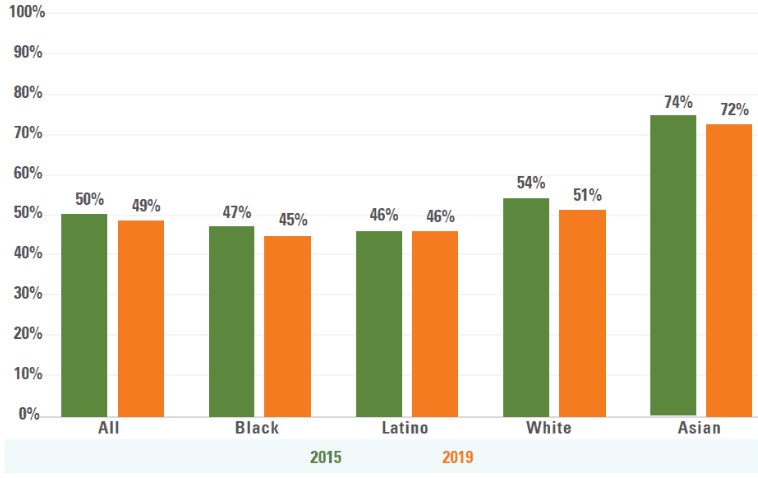
FIGURE 1: PERCENTAGE OF HIGH SCHOOL GRADUATES WHO ENROLLED IN COLLEGE IN THE FOLLOWING FALL SEMESTER OVER TIME, FALL 2015 TO FALL 2019
Source: Texas Higher Education Data, High School Graduates Enrolled in Higher Education, High School Graduates Enrolled in Higher Education the Following Fall: Statewide Summary by Ethnicity and Higher Education Sector, Fall 2000 to Fall 2019. Includes Texas students attending public 4-year, 2-year and independent universities.
Academic instruction, curriculum, and performance in high school are powerful predictors of college completion.[ 19 ] Even when Texas students do graduate high school, too many have not been prepared to succeed in college, and consequently, are not completing their degree. Nearly 40% of students entering a Texas public higher education institution did not meet college-readiness standards established by the Texas Success Initiative (Figure 2). And of those students, only 58% returned to college for their second year, compared to 83% of students who were college ready (Figure 2). Unprepared students go on to take remedial courses, which cost money, and do not earn students credit, which makes it harder for students to progress toward a degree. If unsupported, students who are not college ready can get stuck in remedial courses and never complete college (Figure 2).
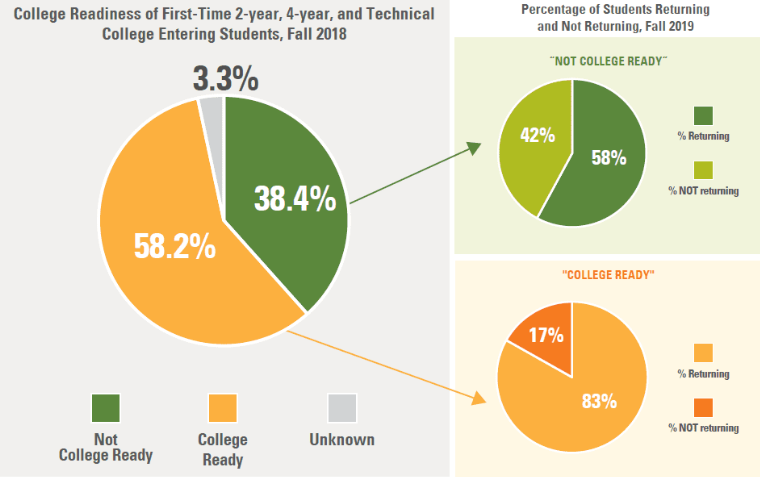
FIGURE 2: COLLEGE READINESS AND CONTINUATION OF FIRST-TIME 2-YEAR, 4-YEAR, AND TECHNICAL COLLEGE STUDENTS IN TEXAS
Source: Texas Higher Education Coordinating Board, Developmental Education Accountability Measures Data (Texas Success Initiative), Universities Statewide, Community Colleges Statewide, and TSTCs/LAMARs Statewide. Texas Success Initiative requires all entering college students to be assessed for college readiness in reading, writing, and math or demonstrate college readiness through successful completion of college-level coursework in the related content area.
While Texas’ P-12 schools must prepare students for postsecondary, higher education institutions must be intentional about providing access and supporting students to complete college. Of the degree-seeking students who enrolled in a Texas public university or two-year college in 2013, just half (52%) graduated from a Texas university within six years, and there are significant racial disparities. Only 36% of Black students and 48% of Latino students graduated within six years, compared with 60% of White students.[ 20 ] This should not be the case. Closing funding gaps across higher education institutions would be a step toward greater equity. Texas institutions providing the best access for students of color, like historically Black colleges and universities (HBCUs) receive less state funding (an average of $2,500 less per student) than predominately White state flagships, which means fewer resources to support college completion.[ 21 ] With investment, Texas can improve Black and Latino student success.
At every step along the path to and through college, Texas schools let students, especially Black and Latino students, fall off the path to college completion. The data shows that fewer than a quarter of the 2009 eighth grade class graduated from a Texas higher education institution 10 years later. Even fewer Black students (15%), Latino students (18%), and students from low-income backgrounds (14%) graduated from a Texas college that same year (Figure 3). These outcomes paint a bleak picture for Texas’ future. There is an urgent need to address postsecondary attainment gaps and ensure students are prepared to transition to college and the workforce.
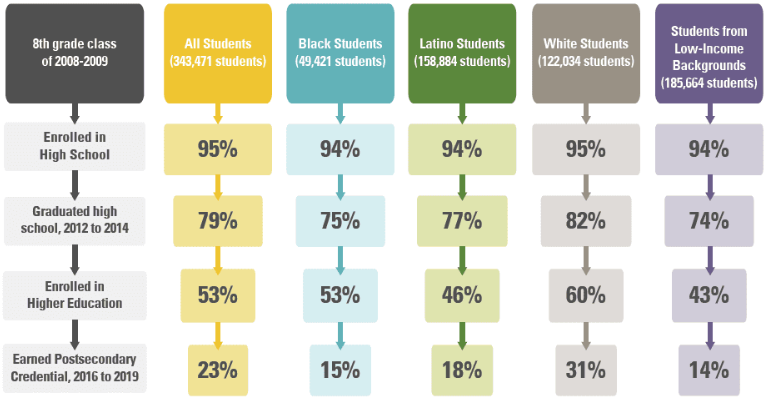
FIGURE 3: TEXAS 8TH GRADE COHORT OUTCOMES BY RACE/ETHNICITY AND INCOME, FY 2009-2019
Source: Texas Higher Education Coordinating Board (THECB), Higher Education Dashboard, 8th Grade Cohorts Tracked through Higher Education, FY 2009.
TEXAS MUST PROMOTE TIGHTER COORDINATION BETWEEN P-12 AND HIGHER EDUCATION SYSTEMS. BELOW ARE TWO RECOMMENDATIONS TO EASE TRANSITIONS AND BOOST COLLEGE COMPLETION:
- Strengthen data capacity and systems between the Texas Higher Education Coordinating Board, Texas Workforce Committee, and the Texas Education Agency, to provide timely, actionable data to students and the adults supporting them in high school and higher education (educators and counselors) to increase the effectiveness of student advising.[ 22 ]
- Increase state budget appropriations for need-based student financial aid and minority-serving institutions, like HBCUs and community colleges, which serve students from diverse backgrounds in Texas, to ensure all students have the resources and supports they need to access and complete their postsecondary education.[ 23 ]
TEXAS MUST SUPPORT STUDENT POSTSECONDARY READINESS BY PROVIDING EQUITABLE ACCESS TO ADVANCED COURSES
Texas students need access to rigorous and advanced courses to be prepared for college and careers in Texas’ future economy. Research shows that students who take college-level courses in high school are more likely to graduate, go on to college, and earn a degree.[ 24 ] Data shows that Texas Black and Latino students, and students from low-income backgrounds can be successful if given the opportunity, but are denied equitable access to critical opportunities at every stage — gifted and talented programs in elementary school; Algebra I courses in middle school; and Advanced Placement (AP), International Baccalaureate, and dual credit programs in high school.[ 25 ]
GIFTED AND TALENTED PROGRAMS
The vast majority (95%) of elementary schools in T exas offer gifted and talented programs. [ 26 ] These programs can open the door for future advanced coursework opportunities and can change educators’ perceptions of students, especially students of color.[ 27 ] Nationally, there are barriers to gifted and talented programs (referral, identification, and enrollment) for Black and Latino students. [ 28 ] Texas has taken positive steps to ensure that students are equitably identified, for example, by requiring all kindergarten students be automatically considered for gifted and talented, requiring that schools use multiple measures to determine eligibility (e.g., data is collected through three or more methods and used to determine whether a student qualifies for g ifted and talented services), and requiring districts to communicate assessment policies to families.[ 29 ]
Even with these policies in place, Black and Latino students remain underrepresented in gifted and talented programs. A 2019 Ed Trust report found that enrollment in gifted and talented programs in elementary school does not reflect overall student enrollment in Texas: There are 80 Latino students and just 59 Black students enrolled for every 100 students who should be enrolled to be fairly represented.[ 30 ] Texas leaders should focus attention on identifying remaining barriers that block Black and Latino students from gifted and talented programs and support program implementation in districts and schools that serve under-identified students.
TEXAS CAN FURTHER EQUITABLE ACCESS TO GIFTED AND TALENTED PROGRAMS AND OTHER ADVANCED OPPORTUNITIES BY:
- Issuing guidance to districts and schools to encourage the use of data to identify barriers to opportunity for Black and Latino students in Texas. Data can unearth bias and resource gaps in the implementation of advanced programs and courses that lock students out.
EIGHTH GRADE ALGEBRA I
By middle school, many Texas students encounter barriers to enrollment in advanced, rigorous math courses, like eighth grade algebra. Enrollment in Algebra I in middle school is a “gateway” to advanced math courses in high school and can ensure students are on a college- and career-ready path. Research also shows that students who take eighth grade algebra are more likely to experience a host of positive outcomes, including graduating high school on-time.[ 31 ]
But Black and Latino students and students from low-income backgrounds are under-placed into advanced math pathways, [ 32] and were less likely to be enrolled in Algebra I in eighth grade than their White and higher-income peers in 2019 (Figure 4). The role that implicit and explicit bias plays in producing this pattern cannot be denied, especially since even the highest-performing Black and Latino students and students from low-income backgrounds, are underrepresented in advanced math in Texas. [ 33]
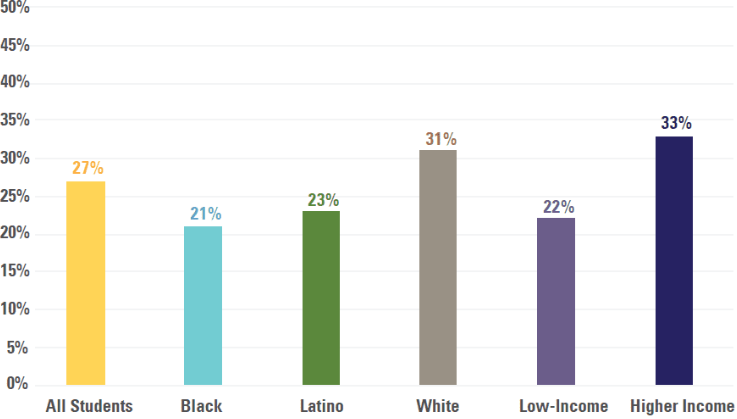
FIGURE 4: PERCENTAGE OF TEXAS 8TH GRADERS TAKING ALGEBRA I BY RACE/ETHNICITY AND INCOME, 2019
Source: National Center for Education Statistics, National Assessment of Educational Progress, NAEP Data Explorer, 2019.
THE EQUITY IMPLICATIONS OF ELIMINATING ALGEBRA II FROM HIGH SCHOOL REQUIREMENTS
In 2014, Texas’ Foundation High School Program (HB5) eliminated Algebra I I as a math requirement for graduation. Instead of requiring Algebra II as part of four required math courses, the state allows students to take two other classes above geometry: algebraic reasoning and statistics. The new requirements began with the 2014-15 cohort of ninth graders, and the high school class of 2018 was the first to graduate under these changes.[ 34 ]
These graduation changes will have implications for college and career readiness. Algebra II is still considered a rigorous college preparatory course that students are encouraged to take.[ 35 ] Also, the more rigorous the math course a student takes in high school, the more likely the student would enroll, persist, and complete a postsecondary credential.[ 36 ] Opting out of Algebra II also means a student cannot qualify for certain scholarship programs or gain automatic admission to a state public university under Texas’ Top 10% Rule. Under this rule, students in the top 10% of their graduating classes are eligible for automatic admission to any public university in Texas.[ 37 ]
The graduation adjustments may have the largest negative impact on Black and Latino students, and students from low-income backgrounds. Students from low-income backgrounds are already less likely to complete and pass Algebra II than students from higher-income backgrounds. White and Asian students are also supported to have persistently higher completion and passing rates than their Black and Latino peers.[ 38 ] A recent study also found sharp declines in Algebra II enrollment in rural districts.[ 39 ] Future research must continue to track cohorts of students over their high school career to determine whether course-taking patterns change, college-going rates decline, or equity gaps widen in response to HB5.
ADVANCED PLACEMENT
In high school, Advanced Placement and dual credit courses play a critical role in making postsecondary education accessible and affordable by offering students college-level content and granting them both college and high school credit.[ 40 ] Students who earn AP, International Baccalaureate, or academic dual enrollment credits in the 12th grade are more likely to attend college and complete a degree than students who earn none.[ 41 ]
The majority of students in Texas (85%) attend schools that offer a diverse range of AP cour ses in math, science, and other content areas.[ 42 ] But despite the widespread availability of these courses, many Black students, Latino students, and students from low-income backgrounds, are excluded from AP courses (Figure 5).
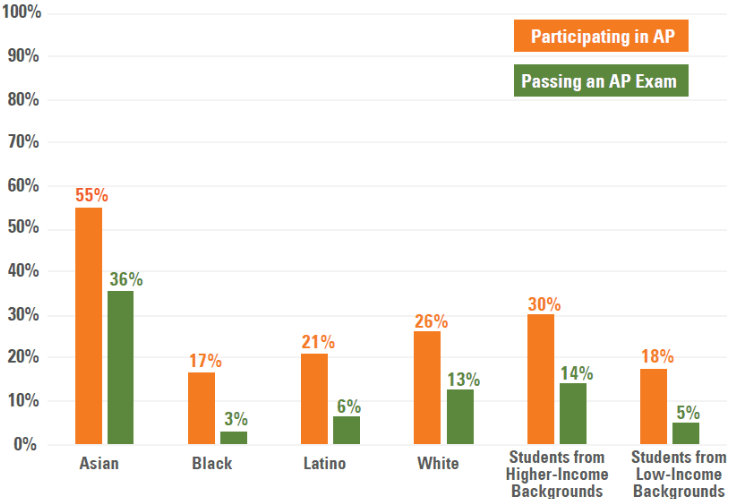
FIGURE 5: PERCENTAGE OF TEXAS HIGH SCHOOL STUDENTS ENROLLED IN AT LEAST ONE AP COURSE AND PERCENTAGE OF HIGH SCHOOL STUDENTS WHO PASS AN AP EXAM BY RACE/ETHNICITY AND INCOME, 2017
Source: Texas Public Education Information Resource (TPEIR), Advanced Placement (AP), Texas Public High School Student Participation in Advanced Placement (AP) Courses and Exams – Statewide.
Of course, access is not enough. Too few high school students from low-income backgrounds, Black students, and Latino students in Texas earn college credit through AP courses. Of all Texas high school students, only 3% of Black students, 6% of Latino students, and 5% of students from low-income backgrounds were supported to take AP and earn college credit in 2017 (Figure 5). Texas schools are not supporting its Black and Latino students t o succeed in advanced coursework as well as other states. In 2019, Texas AP passing exam rates were below the national average for Black students and Latino students.[ 43 ]
TEXAS STATE LEADERS CAN REMOVE BARRIERS TO ADVANCED AND RIGOROUS COURSES BY:
- Requiring districts to institute policies and practices to expand eligibility for advanced courses. For example, requiring districts to use multiple measures to identify and automatically enroll eligible students into advanced courses.
- As part of the Texas Tri-Agency Pathways, provide training and resources to support Black, Latino, and low-income students’ success in advanced courses. Support district implementation of additional advanced coursework preparation, teacher training, tutoring, and extended learning time for students who need it.
DUAL CREDIT
Similar to AP, dual credit courses offer high school students the opportunity to earn college credit through rigorous, college-level courses. These courses have become increasingly popular in Texas: Between 1999 and 2019, the number of high school students taking at least one dual credit course rose from about 12,000 to more than 200,000; this represents about 13% of the Texas high school population.[ 44 ] The percentage of high school students taking dual credit courses in Texas has risen for all student groups and, as a result of the changing demographic makeup of Texas, has grown more ethnically and racially diverse.[ 45 ] However, disparities in dual credit participation persist and may be driven by access barriers across Texas high schools according to a study that found White students, higher income students, and students who were enrolled in gifted and talented programs were significantly more likely to participate in dual credit, relative to Black students, Latino students, and students from low-income backgrounds in Texas. Between 2012 and 2015, Black students were about 9 percentage points and Latino students 5 percentage points less likely than White students with similar characteristics to participate in dual credit in 12th grade.[ 46 ]
Dual credit seniors have higher college-going rates than the average high school student but, even when taking these courses, not every student goes on to college, and Black and Latino dual credit seniors have lower collegegoing rates than White dual credit seniors (Figure 7). The main purpose of taking dual credit or AP courses is to earn postsecondary credit, so it would be expected that students taking these courses go on to college. Unfortunately, schools may not be providing the guidance needed for students to make that transition.
BETWEEN 2012 AND 2015, BLACK STUDENTS WERE ABOUT 9 PERCENTAGE POINTS AND LATINO STUDENTS 5 PERCENTAGE POINTS LESS LIKELY THAN WHITE STUDENTS WITH SIMILAR CHARACTERISTICS TO PARTICIPATE IN DUAL CREDIT IN 12TH GRADE
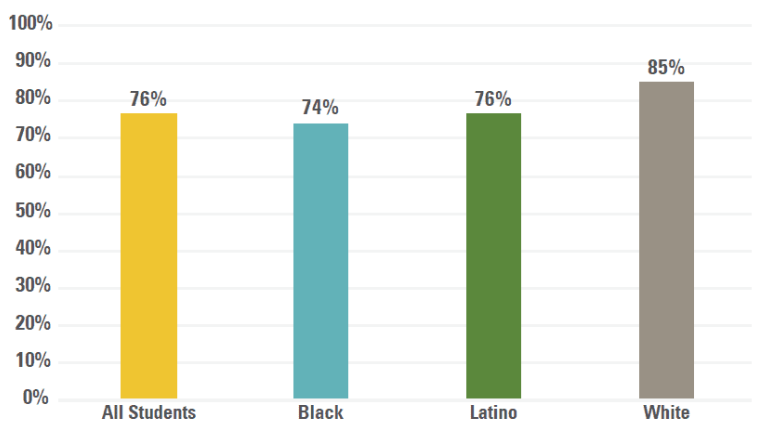
FIGURE 6: DUAL CREDIT SENIORS COLLEGE-GOING RATES BY RACE/ETHNICITY, 2018
Source: Texas Higher Education Coordinating Board, Strategic Planning and Funding, 60x30TX Progress Report, July 2019.
This can be partly due to a lack of transparency in data collection, reporting, and accountability, which has failed to keep pace with dual credit program growth. Confusion and inconsistencies exist around dual credit course sequences and transferability to higher education institutions.[ 47 ] Unlike AP, dual credit standards are inconsistent or unclear, which can harm dual credit students’ ability to gain the full benefits of these courses, like earning college credit, saving money, and reducing college debt burdens in the long term.[ 48 ]
DUAL CREDIT PROGRAMS ARE GAINING POPULARITY IN TEXAS. STATE LEADERS MUST PLAY AN ACTIVE ROLE IN LEVELING THE DUAL CREDIT LANDSCAPE. RECOMMENDATIONS INCLUDE:
- As recommended by the Texas Dual Credit Task Force, convened by the University of Texas System and the Texas Association of Community Colleges (TACC), set equity goals and build better data systems to address dual enrollment access, eligibility, participation and completion gaps among identified student populations and geographic areas.
- Collect and publish data on dual credit outcomes, credit transfer rates, and courses of study disaggregated by race/ethnicity, income, and English learner status.
- Create statewide standards for dual credit courses to ensure that dual credit is widely transferrable and held to consistent and rigorous expectations throughout Texas.
Texas’ P-12 system has the responsibility to lay the groundwork for college and career success. But the data shows that students from low-income backgrounds, Black students, and Latino students face persistent barriers — from elementary to high school — to accessing advanced and rigorous courses that prepare them for critical educational transitions. Without targeted policy efforts, Texas risks falling short of its 60x30TX higher education goals.
TEXAS MUST STRENGTHEN POLICY EFFORTS TO PROMOTE EQUITY IN CCMR AND CLOSE LONGSTANDING POSTSECONDARY ATTAINMENT GAPS
Texas’ 2019 Legislature established CCMR Outcomes Bonuses in HB3, to incentivize and reward districts that graduate students, particularly students from low-income backgrounds and students served by special education programs, who demonstrate readiness for postsecondary pathways.[ 49 ] The bill instates bonuses for each annual graduate above a specific percentage threshold who meets the definition of college ready, career ready, or military ready. The program also provides reimbursements for free college preparatory assessments or industry recognized certification exams, educator professional development, student counseling, preparation, and FAFSA or TASFA form support, among other allowable uses that promote CCMR.[ 50 ] The Texas Legislature intended the HB3 CCMR efforts to further the state’s 60x30TX goals. While Texas can leverage CCMR bonuses and reimbursements to expand district efforts to prepare students for postsecondary success, the state can do much more to build on this effort. Texas must protect and continue to invest in programs that expand access to advanced coursework, such as the Texas Tri-Agency Pathways resources, which support districts and educators in creating college and career pathways for their students.[ 51 ] More statewide data and alignment is needed to build on Texas’ SB25, which mandates that colleges and universities report dual credit courses that don’t transfer and requires Texas colleges to develop at least one recommended course sequence for every certificate or degree program. These actions can help address the lack of transparency in dual credit programs and the accumulation of non-transferrable credits. Overall, Texas initiatives and funding should be targeted to the states’ underserved Black students, Latino students, and students from low-income backgrounds who currently face barriers to opportunity and will make up a larger share of Texas’ future population.
RECOMMENDATIONS TO STRENGTHEN TEXAS CCMR EFFORTS INCLUDE:
- Maintain and monitor HB3 allotments and state programs that further CCMR. For example:
- Maintain and monitor the FAFSA/TASFA graduation requirement which has promise to boost financial aid form completion rates for higher education.[ 52 ] Ensure special considerations are taken for undocumented students and families, as well as counselor capacity at the school level.
- Ensure that HB3 CCMR outcomes-based funding is used to close gaps within and across districts, including access to and completion of advanced coursework.
- Expand state investment in waivers for exams, subsidies for instructional materials, or transportation to attend advanced courses, given that COVID-19 exacerbates the financial challenges for many families.
TEXAS MUST RE-COMMIT TO ITS 60X30TX GOALS AND ACT NOW TO IMPLEMENT POLICIES AND PRACTICES TO ACHIEVE THOSE GOALS
Texas still has work to do to ensure Texas’ Black and Latino students, and students from low-income backgrounds have equitable access to advanced courses and are prepared for the postsecondary path of their choice, whether that be college, career, or military. The following are actions the state should take:
- Strengthen data capacity and systems between the Texas Higher Education Coordinating Board, Texas Workforce Committee, and the Texas Education Agency, to provide timely, actionable data to students and the adults supporting them in high school and higher education (educators and counselors) to increase the effectiveness of student advising.
- Increase state budget appropriations for need-based student financial aid and minority-serving institutions, like HBCUs and community colleges, which serve students from diverse backgrounds in Texas, to ensure all students have the resources and supports they need to access and complete their postsecondary education.
- Issue guidance to districts and schools to encourage the use of data to identify barriers to opportunity for Black and Latino students in Texas. Data can unearth bias and resource gaps in the implementation of advanced programs and courses that lock students out.
- Require districts to institute policies and practices to expand eligibility for advanced courses. For example, requiring districts to use multiple measures to identify and automatically enroll eligible students into advanced courses.
- As part of the Texas Tri-Agency Pathways, provide training and resources to support Black, Latino, and low-income students’ success in advanced courses. Support district implementation of additional advanced coursework preparation, tutoring, and extended learning time for students who need it.
- As recommended by the Texas Dual Credit Task Force, convened by the University of Texas System and the Texas Association of Community Colleges (TACC), set equity goals and build better data systems to address dual enrollment access, eligibility, participation and completion gaps among identified student populations and geographic areas.
- Collect and publish data on dual credit outcomes, credit transfer rates, and courses of study disaggregated by race/ethnicity, income, and English learner status.
- Create statewide standards for dual credit courses to ensure that dual credit is widely transferrable and held to consistent and rigorous expectations throughout Texas.
- Maintain and monitor HB3 allotments and state programs that further CCMR. For example:
- Maintain the FAFSA/TASFA graduation requirement, which has promise to boost financial aid form completion rates for higher education. Ensure special considerations are taken for undocumented students and families, as well as counselor capacity at the school level.
- Ensure that HB3 CCMR outcomes-based funding is used to close gaps within and across districts, including access to and completion of advanced coursework.
- Expand state investment in waivers for exams, subsidies for instructional materials, or transportation to attend advanced courses, given that COVID-19 exacerbates the financial challenges of many families.
ACHIEVING 60X30TX GOALS WILL SECURE THE TEXAS’ ECONOMIC VITALITY AND FUTURE
The current pandemic and recession underscore the importance of investing in students, who are the foundation of Texas’ economic future. 60x30TX goals are incredibly relevant in our current context. Texas students need equitable access to advanced coursework and opportunities that promote CCMR in P-12 schools to become the productive citizens of tomorrow. For this reason, Texas must act now so students, particularly, students from low-income backgrounds, Black students, and Latino students, can reach their full potential.
ENDNOTES
1. Elephant, M. (July 2019). “The ‘Texas Miracle’ Missed Most of Texas.” The New York Times. Retrieved from: nytimes.com
2. Carnevale, A.P., Smith N., and Strohl J. (June 2013). Recovery: Projections of Jobs and Education Requirements Through 2020. Georgetown Public Policy Institute. Retrieved From: 1gyhoq479ufd3yna29x7ubjn-wpengine.netdna-ssl.com
3. Texas Higher Education Coordinating Board (July 2019). 60x30TX Progress Report. Strategic Planning and Funding. Retrieved from: reportcenter.highered.texas.gov
4. Texas Higher Education Coordinating Board (July 2019). 60x30TX Progress Report. Strategic Planning and Funding. Retrieved from: reportcenter.highered.texas.gov
5. Ed Trust Analysis of Texas Higher Education Coordinating Board (July 2019). 60x30TX Progress Report. Strategic Planning and Funding. Page 35. Retrieved from: reportcenter.highered.texas.gov
6. Dorn E., Hancock B., Sarakatsannis J., and Viruleg E. (June 2020). COVID-19 and student learning in the United States: The hurt could last a lifetime. McKinsey & Company. Retrieved from: mckinsey.com
7. Dorn E., Hancock B., Sarakatsannis J., and Viruleg E. (June 2020). COVID-19 and student learning in the United States: The hurt could last a lifetime. McKinsey & Company. Retrieved from: mckinsey.com ; Mcgee K. (December 2020). Texas enrollment and FAFSA applications down, as education leaders worry pandemic is disrupting college plans. The Texas Tribune. Retrieved from: texastribune.org
8. National Student Clearinghouse Research Center (November 2020). COVID-19 Stay Informed with the Latest Enrollment Information: Fall 2020 Enrollment (As of Oct 22). Retrieved from: nscresearchcenter.org
9. Patrick, K., Socol Rose A., and Morgan I. (January 2020). Inequities in Advanced Coursework. The Education Trust. Retrieved from: edtrust.org advanced-coursework/; Theokas, C. and Saaris, R. (June 2013). Finding America’s Missing AP and IB Students. The Education Trust. Retrieved from: edtrust.org
10. Texas Higher Education Coordinating Board (July 2019). 60x30TX Progress Report. Strategic Planning and Funding. Retrieved from: reportcenter.highered.texas.gov
11. Texas Higher Education Coordinating Board (July 2019). 60x30TX Progress Report. Strategic Planning and Funding. Retrieved from: reportcenter.highered.texas.gov
12. Ed Trust analysis of Custom Census Tables, ACS 5-Year Estimates – Public Use Microdata Sample (2018), Universe: Texas Age 25-34, Educational Attainment: Associate’s degree, Bachelor’s degree, Master’s degree, Professional degree beyond a bachelor’s degree, Doctorate degree. *Excludes Texas population that holds a postsecondary credential.
13. Ed Trust analysis of Custom Census Tables, ACS 5-Year Estimates – Public Use Microdata Sample (2018), Universe: Texas Age 25-34, Educational Attainment: Associate degree, Bachelor’s degree, Master’s degree, Professional degree beyond a bachelor’s degree, Doctorate degree. Retrieved from: data.census.gov *Excludes Texas population that holds a postsecondary credential.
14. Texas tracks 60x30TX completion progress for the number of certificates, associate degrees, bachelor’s (baccalaureate) degrees, and master’s degrees awarded by Texas public, private (independent), and for-profit (career) institutions of higher education. Certain institutions located outside Texas serving residents or conducting services in Texas, are also included. Certificates include lower-level undergraduate certificates (for public 4-year institutions), and Level 1, Level 2 (undergraduate certificates) and Advanced Technology Certificates (for public 2-year institutions). No military data included. For more information see: txhigheredaccountability.org
15. Texas Higher Education Coordinating Board. (October 2017). Overview: Texas Success Initiative. Retrieved from: reportcenter.highered.texas.gov
16. Commissioner Mike Morath (n.d.). Statewide Dual Credit Goals. Texas Education Agency. Retrieved from: capitol.texas.gov
17. Texas Education Agency. (August 2019). HB3 in 30: College, Career, or Military Readiness Outcomes Bonus and Exam Reimbursements. Retrieved from: tea.texas.gov
18. Ed Trust analysis of National Center for Education Statistics. (November 2019). Table 1. Public high school 4-year adjusted cohort graduation rate (ACGR), by race/ethnicity and selected demographic characteristics for the United States, the 50 states, the District of Columbia, and Puerto Rico: School year 2017–18. Retrieved from: nces.ed.gov
19. Adelman, C. (February 2006). The Toolbox Revisited: Paths to Degree Completion from High School Through College. Office of Vocational Adult Education. US Department of Education. Retrieved from: files.eric.ed.gov
20. Ed Trust analysis of Texas Higher Education Accountability System. (April 2020). Graduation_Rates. Retrieved from: txhigheredaccountability.org *Data may exclude Texas university students who completed their degree at a non- Texas institution or university.
21. Williams, A. (February 2020). Underfunded. But Why? The story of Texas’ lack of investment in Historically Black Colleges and Universities. Center for Public Policy Priorities. Retrieved from: everytexan.org
22. Educate Texas. (August 2020). Re: Request for Information Related to Interim Charge 3. Letter retrieved from: capitol.texas.gov
23. Williams, A. (February 2020). Underfunded. But Why? The story of Texas’ lack of investment in Historically Black Colleges and Universities. Center for Public Policy Priorities. Retrieved from: everytexan.org
24. Adelman, C. (February 2006). The Toolbox Revisited: Paths to Degree Completion from High School Through College. Office of Vocational Adult Education. US Department of Education. Retrieved from: files.eric.ed.gov
25. Patrick, K., Socol Rose A., and Morgan I. (January 2020). Inequities in Advanced Coursework. The Education Trust. Retrieved from: edtrust.org
26. Patrick, K., Socol Rose A., and Morgan I. (January 2020). Inequities in Advanced Coursework. The Education Trust. Retrieved from: edtrust.org
27. Patrick, K., Socol Rose A., and Morgan I. (January 2020). Inequities in Advanced Coursework. The Education Trust. Retrieved from: edtrust.org
28. Ford, D. Y., Wright, B. L., and Trotman Scott, M. (2020). A Matter of Equity: Desegregating and Integrating Gifted and Talented Education for Under-Represented Students of Color. Multicultural Perspectives, v22 n1. Retrieved from: eric.ed.gov
29. Texas Education Agency. (April 2019). Texas State Plan for the Education of Gifted/Talented Students. Retrieved from: tea.texas.gov
30. Ed Trust (January 2020). Advanced Coursework in Your State. The Education Trust. Retrieved from: edtrust.org
31. Sorensen, N. et. al. (November 2018). Poster Paper: Expanding Access to 8th Grade Algebra: Does Readiness Matter? APPAM Conference. Retrieved from: appam.confex.com
32. Ed Trust (January 2020). Advanced Coursework in Your State. The Education Trust. Retrieved from: edtrust.org
33. Bailie, C. and Wiseman, A. (January 2018). Improving Equity and Driving Degree Completion through Acceleration in Mathematics. E3 Alliance. Retrieved from: e3alliance.org
34. Stoker, G., Mellor, L., and Sullivan, K. (February 2018). Trends in Algebra II completion and failure rates for students entering Texas public high schools. American Institutes for Research. Retrieved from: ies.ed.gov
35. Smith, D. (February 2014). “Algebra 2 no longer required in Texas but don’t expect college without it.” Fort Worth Star- Telegram. Retrieved from: star-telegram.com
36. Bailie, C. and Wiseman, A. (January 2018). Improving Equity and Driving Degree Completion through Acceleration in Mathematics. E3 Alliance Education Equals Economics. Retrieved from: e3alliance.org
37. Smith, D. (February 2014). “Algebra 2 no longer required in Texas but don’t expect college without it.” Fort Worth Star- Telegram. Retrieved from: star-telegram.com
38. Stoker, G., Mellor, L., and Sullivan, K. (February 2018). Trends in Algebra II completion and failure rates for students entering Texas public high schools. American Institutes for Research. Retrieved from: ies.ed.gov
39. Bojorquez, H., Bahena, S. (2017). Ready Texas -A Study of the Implementation of HB5 in Texas and Implications for College Readiness. Intercultural Development Research Association. Retrieved from: files.eric.ed.gov
40. American Institutes for Research. (December 2018). Dual Credit Education Programs in Texas: Phase II. Retrieved from: 60x30tx.com
41. Holzman, B. (April 2018). Transitioning to College and Work Part I: Where are high school seniors from 2006–2008 now? Rice University ‘s Kinder Institute for Urban Research. Retrieved from: kinder.rice.edu
42. Ed Trust (January 2020). Advanced Coursework in Your State. The Education Trust. Retrieved from: edtrust.org
43. Ed Trust analysis of College Board, AP Program Participation and Performance Data 2019, National and Texas State Summary Reports for 2019. Texas. Retrieved from: research.collegeboard.org
44. Ed Trust analysis of Texas Higher Education Coordinating Board, Total and Dual Credit Enrollment at Texas Higher Education Institutions, Fall Semesters 1999- 2019. Retrieved from: thecb.state.tx.us
45. Ed Trust analysis of Texas Higher Education Coordinating Board, Total and Dual Credit Enrollment at Texas Higher Education Institutions, Fall Semesters 1999- 2019. Retrieved from: thecb.state.tx.us Miller, T. et al. (2017). Dual Credit Education in Texas Interim Report. RAND Corporations. Retrieved from: rand.org
46. Miller, T. et al. (2017). Dual Credit Education in Texas Interim Report. RAND Corporations. Retrieved from: rand.org
47. Hryhorchuk, J. (2019). House Higher Education Interim Charge 1. Texas 2036. Retrieved from: capitol.texas.gov
48. Hryhorchuk, J. (2019). House Higher Education Interim Charge 1. Texas 2036. Retrieved from: capitol.texas.gov
49. Texas Education Agency. (December 2019). House Bill 3 (HB 3) Implementation: CCMR Outcomes Bonus Allowable Expenses. Retrieved from: tea.texas.gov
50. Texas Education Agency. (December 2019). House Bill 3 (HB 3) Implementation: CCMR Outcomes Bonus Allowable Expenses. Retrieved from: tea.texas.gov
51. Texas Education Agency. (n.d.). Pathways Initiatives. College, Career, & Military Preparation. Retrieved from: tea.texas.gov
52. Granville, P. (July 2020). Should States Make the FAFSA Mandatory? The Century Foundation. Retrieved from: tcf.org



